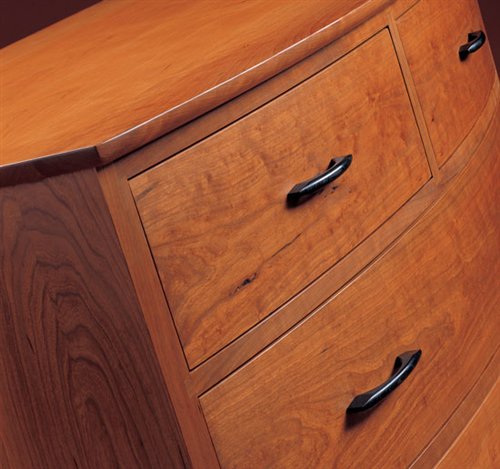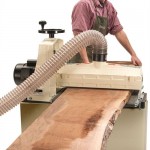We may receive a commission when you use our affiliate links. However, this does not impact our recommendations.
The Magic of Cherry
"No wood can rival the depth and complexity of cherry's color and figure." – Thos. Moser
By Tom Caspar
I’m sitting at a figured-cherry writing desk I built more than 20 years ago. I intimately know every square inch, but when my eyes wander from my laptop computer to the wood, it always captures my imagination. What is it about old cherry that’s so endlessly fascinating? Cherry is surprisingly bland when freshly planed, but after a few years, it glows like the embers of a warm, comforting campfire. To make that magic happen doesn’t require smoke and mirrors, though, just smart purchasing and shrewd woodworking skills.
Cherry's Allure
For my home, dark walnut is too formal, light maple too stark. I prefer working with American hardwoods rather than imported species, so when I want a medium-toned wood to relax with in my home, I build with cherry. It’s fairly easy to work, like walnut or red oak, but the real appeal for me is its rich appearance.
|
Exceptional Curly Figure
Curly figure is quite common in cherry. As you walk around a figured board, the dark areas turn light and the light areas go dark, just like the luster of fine silk. Even a small amount of subtle curly figure under a clear finish can make magic. This stunning 3-D effect is called chatoyancy. Large-scale lumber dealers generally don’t separate curly from straight-grained boards. When lumberyard boards are planed hit-or-miss, you can easily spot the curly wood. With some practice you can even spot chatoyancy in rough, unplaned lumber. Just look for dark ripples that go across the width of the board. |
Click any image to view a larger version. |
|
Age Improves Color
The real beauty of cherry takes time to mature. Cherry is a uniform pale salmon color when first cut, but over the course of a year or so, its surface slowly turns to a dark auburn set against a golden background. It is possible to stain or chemically treat a brand-new project so it looks somewhat like this deep color, but your best bet is simply to use a clear finish and be patient. As with aging a fine wine, let nature do its work. |
|
Beware the Phantom
Cherry needs unobstructed exposure to light and air to turn color evenly. Don’t leave a lamp, book or other solid object on top of your cherry furniture for an extended length of time during its first year. The wood underneath the object won’t darken as fast, which results in a light-colored phantom “shadow” that may never completely disappear. This problem starts when you first plane rough cherry boards. After planing, if you leave them piled willy-nilly overnight, you’ll get shadow lines where they overlapped. At the end of a day’s work, I stand all my boards on edge, separated from one another, so all faces get equal exposure to light and air. |
Matching Color and Figure
The biggest challenge in working with cherry is to select boards that harmoniously blend with each other. I’ve spent hours at a lumberyard picking through piles of cherry, looking for the right family of boards, and the extra time is worth it.
|
Choose Carefully, Don’t Stain
Cherry boards come in many shades. I look for boards that are similar in color and figure so I can use a clear finish and let the wood change color naturally. Many nonwoodworkers assume cherry is very dark and has little or no figure. That’s because most commercial cherry furniture is stained or toned to even out color differences and blend in light-colored sapwood. I understand the economics of this practice, but in my small shop, I consider stain a last resort. It simply obscures the magic. |
|
Buy a Log
Some custom sawmills go to a lot of trouble to restack whole logs after they’ve been cut and dried (see Sources, page 65). This is a gold mine for cherry prospectors. Naturally, this wood will cost a bit more. Most custom mills have a $300 or so minimum order. You can buy an entire log (often called a flitch) or neighboring boards, depending on the mill’s sales policy. Keep in mind that all the wood in a log won’t necessarily be the highest grade. Some boards may have knots and checks. To avoid any misunderstandings, it’s best to phone in rather than e-mail an order. |
|
|
Saw a Giant Board
When it comes to matching color and figure, the next best thing to buying a cut-up log is to saw one yourself. You don’t need a sawmill in your backyard, just a good bandsaw. Look for the longest, widest, thickest cherry board you can find. For a project requiring a modest amount of solid wood, you might get all the parts from one humongous board. Maybe it’ll take two monsters. For maximum yield, rip and resaw the board before planing. |
|
Smart Buying
Whether you’re visiting a local lumberyard or ordering cherry by phone, you’ve got to know the wood and keep up with the lingo. I was recently surprised to learn that you can buy a super-premium grade of cherry if you know what to ask for.
|
The “All-Red” Grade
Be on the alert for light-colored sapwood when you select cherry boards. It’s a dramatically different color than the heartwood. It’s perfectly OK to have sapwood on the hidden, inside face of your boards, but sapwood on the outside face can be very hard to disguise. Sapwood isn’t considered a defect when most cherry is graded. That means Select and Better cherry boards, the highest standard grade, may well contain lots of sapwood, or none at all. Some lumber dealers select cherry boards that have little or no sapwood and sell them at a premium price. They might be labeled as “all-red” or some variation of that phrase. This is a grade that has not been standardized nationally, so the percentage of sapwood allowed varies from dealer to dealer. |
|
Lower Grade = Savings
Prime cherry costs from $5 to $9 per bd. ft. Only a small percentage is designated as the highest Select and Better grade. Grading is based on minimum widths and lengths and a low incidence of knots. No. 1 Common is a lower, less-expensive grade, and there’s plenty available. You just have to plan around the knots or glue narrow boards to make wide ones. Pennsylvania Grows the Best Although good-looking cherry grows throughout the Eastern United States, wood from the Allegheny Plateau in northwestern Pennsylvania has a national reputation for being a more uniform, richer red color than cherry from other regions. Thos. Moser, the founder of a high-end furniture company specializing in cherry for more than 25 years, exclusively uses Pennsylvania cherry.
|
|
|
Watch Out for Gum Pockets
Gum pockets are small black streaks that occasionally form under the bark. Gum pockets aren’t rated as defects when cherry boards are graded, but they can mar the appearance of an otherwise gorgeous board. On the other hand, placed judiciously, gum pockets can add character to an otherwise plain surface. Whatever your philosophy, it’s a good idea to look for gum pockets before you cut full-size boards. |
SourcesNote: Product availability and prices are subject to change. Hearne Hardwoods, hearnehardwoods.com, 888-814-0007, opening quote, by Thomas Moser with Brad Lemley, ©2002. (Used with permission of Chronicle Books LLC, San Francisco, CA; visit us at www.chroniclebooks.com.) This story originally appeared in American Woodworker July 2005, issue #115. |
|
Here are some supplies and tools we find essential in our everyday work around the shop. We may receive a commission from sales referred by our links; however, we have carefully selected these products for their usefulness and quality.


















